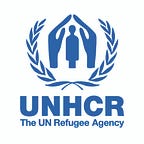The Ugandan school bursting at the seams
Catherine Wachiaya, a UNHCR writer in Kenya, visits a school in northern Uganda where 38 dedicated teachers oversee the education of 5,000 eager students.
At the crack of dawn, Patrick Abale walks out of his tent, nestled amongst several others on the edge of Yangani Primary School, in the Bidibidi refugee settlement in northern Uganda. He strides across the vast compound towards the administration block, drops off his books in the office he shares with the school principal, and turns to look at the first trickle of arriving students.
“When I joined here there were more than 6,000 pupils in this school,” he says, as the sound of feet stamping and shuffling their way to school gradually fills the chilly morning air. I look on as the trickle turns into a torrent — by now students are pouring into the partially fenced compound from all directions. Today, six months after the school was opened, there are still around 5,000 — which, as Patrick notes drily, is “a very big number.”
Patrick, himself a Ugandan, is a deputy principal in charge of academic studies and administration at Yangani. This is a Ugandan state school, and although the children are mostly refugees there are some locals here, too. Despite the massive student numbers, the school has a staff of only 38. Patrick’s ten years of teaching have seen him work in some difficult environments, but Yangani is on a different scale.
“Things are really tough here because there just isn’t enough space for all the students.”
Spread across roughly two acres, the school is a panorama of tattered plastic tents, many with big holes in the sides, flapping in the wind. A gently sloping valley separates the administration area and upper primary classes on the one side from the lower primary classes on the other. Inside the classrooms the temperature soon rises and children on the dusty floors squirm in discomfort.
“Things are really tough here because there just isn’t enough space for all the students,” he says, gesturing into one of the classrooms. We look in on a crowded scene: children occupy every available space, with as many as five sharing a desk. Some sit on the floor, with others standing at the back and in the aisles, clutching their books to their chests. “Sometimes because of the congestion, they stand next to the teacher at the front of the class.”
Yangani school opened in February this year to cater to the rapidly growing numbers of South Sudanese refugees. Uganda has been among the most generous countries in the world in its response to this influx, welcoming refugees, giving them plots of land and opening up public services, including education.
Now host to over two million people who have fled South Sudan — 60 per cent of them children — Uganda is struggling to keep up.
According to the Ministry of Education, the standard teacher-to-student ratio should be 1 to 45. There should be three children to a desk, and 14 to every lavatory. Yangani breaches these rules, and then some. As an administrator, Patrick tries to see to it that learning materials are shared equally across the classes. “We now have 279 textbooks for all students, so you can imagine how tough it is to share,” he says. I try out some mental arithmetic of my own. That’s one textbook to every 18 children.
“We now have 279 textbooks for all students, so you can imagine how tough it is to share.”
UNHCR, the Ugandan education ministry and various partner organizations are looking for ways to increase capacity, setting up more schools and working with national and local officials to identify existing ones that can expand. In this way, they hope to get more refugee children into the national education system at the same time as raising standards for both refugees and local communities. But Uganda cannot do this on its own. “The government is already doing its level best so we are calling for more donor support to fill the gaps,” says Julius Okello, a UNHCR field officer in Bidibidi.
I am introduced to Bashir, a 17-year-old who fled his home in South Sudan last November. Now he lives in Bidibidi as an unaccompanied minor — his parents stayed behind but he has no idea what has happened to them. He had to wait for months before Yangani opened and he could enrol, as there were no other schools nearby. Bashir is in his last year of primary school. He tells me he is doing his best to keep studying diligently but admits it can be hard. “We don’t have enough books. If you get a little money, you can buy some, but most students can’t afford them,” he says. “Some of us who don’t have parents here struggle.”
Seeing the full-to-the-brim classrooms at first hand, you are left in little doubt that there is plenty of demand for education. Most refugees are settled in areas a long way from existing state-run schools. Setting up new ones not only gets refugee children into the national education system, it also raises capacity and standards for local communities. “Schools like Yangani are filling a crucial gap,” Okello says.
But he adds that it is hard for the children to learn under these constrained circumstances. “There are no boundaries to separate the classes. Two different classes take place next to each other, so whatever is being taught in one class is heard in the next one.”
Patrick surveys the massed ranks of children before heading off to teach another class. “Imagine only 38 teachers for all these students,” he remarks as he sets off. “You can get overwhelmed.”
Read the report: Left Behind: Refugee Education in Crisis.
